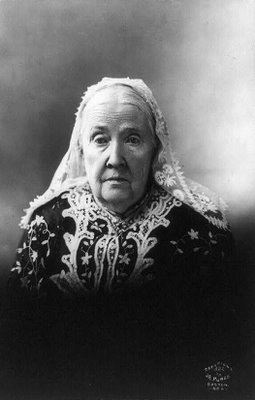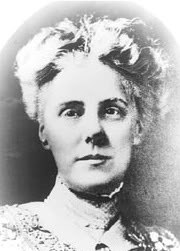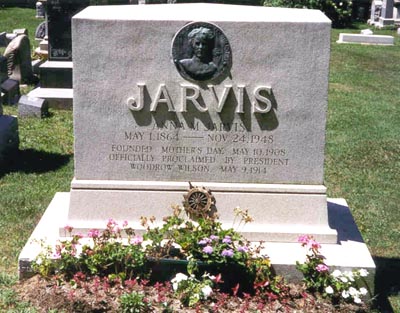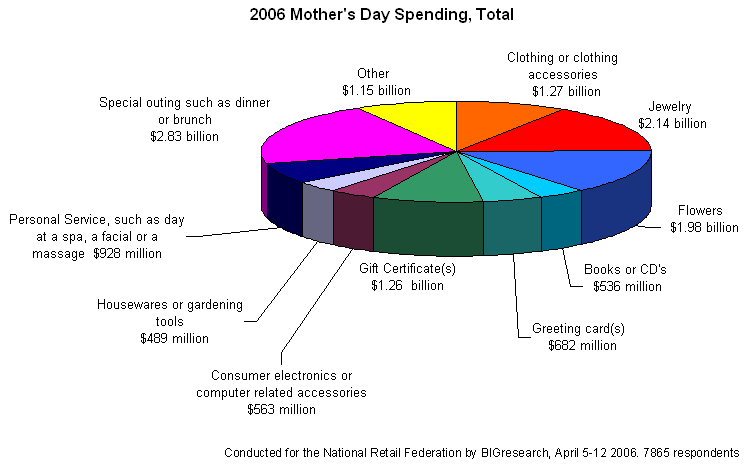The orgins of mothers day.
Mother's Day History
The majority of countries that celebrate Mother's Day do so on the second Sunday of May. On this day, it is common for Mothers to be lavished with presents and special attention from their families, friends and loved ones.
But it wasn't always this way...
Spiritual Origin of Mothers Day
Only recently dubbed “Mother's Day,†the highly traditional practice of honoring of Motherhood is rooted in antiquity, and past rites typically had strong symbolic and spiritual overtones; societies tended to celebrate Goddesses and symbols rather than actual Mothers. The personal, human touch to Mother’s Day is a relatively new phenomenon. The maternal objects of adoration ranged from mythological female deities to the Christian Church itself. Only in the past few centuries did celebrations of Motherhood develop a decidedly human focus.
Goddess Isis - Early Egyptian Roots
One of the earliest historical records of a society celebrating a Mother deity can be found among the ancient Egyptians, who held an annual festival to honor
the goddess Isis, who was commonly regarded as the Mother of the pharaohs. Her stern, yet handsome head is typically crowned by a pair of bull horns enclosing a fiery sun orb. She is most often depicted sitting on a throne.
So the story goes, after Isis’ brother-husband Osiris was slain and dismembered in 13 pieces by their jealous brother Seth, Isis re-assembled Osiris’ body and used it to impregnate herself. She then gave birth to Horus, whom she was forced to hide amongst the reeds lest he be slaughtered by Seth. Horus grew up and defeated Seth, and then became the first ruler of a unified Egypt. Thus Isis earned her stature as the Mother of the pharaohs.
It is interesting to note that the Mother and Son imagery of Isis and Horus—in which Isis cradles and suckles her son—is strikingly similar to that of the Virgin Mary and baby Jesus.
Cybele - Ancient Roman Celebration
The festival of Isis was also celebrated by the Romans who used the event to commemorate an important battle and mark the beginning of Winter. Despite being an imported deity, Isis held a place at the Roman temple, and her festival—which lasted for three days—was regaled by mostly-female dancers, musicians and singers.
Yet the Roman root of Mother’s Day is perhaps more precisely found in the celebration of the
Phrygian goddess Cybele, or Magna Mater (Great Mother).
Cybele stems from the Greek Goddess Rhea, who was the Mother of most of the major deities including Zeus. Rhea was therefore celebrated as a mother goddess, and the festival took place around the time of the Vernal Equinox.
Greek Celebration of Rhea, the Mother of the Gods
In Rome and Asia Minor, Cybele was the major Mother deity most similar to
Rhea, the Greek mother of the Gods. Other societies worshipped similar deities including Gaia the Earth Goddess and Meter oreie the Mountain Mother. In many aspects, this Mother goddess was represented and celebrated similarly across cultures.
The Anatolian mother goddess festivals, however, were said to be so wild that they were eventually discouraged or banned. But more conservative celebrations of Cybele and her equivalents included eating honey cakes and sharing flowers in the morning. This was practiced throughout Asia Minor—and eventually in Rome.
The Roman celebration of Magna Mater fell between March 15 and March 22, just around the same time as the Greek festival in honor of Rhea. Referred to as Hilaria, games were held in honor of the Mother of the gods. Also customary was a procession through the streets with a statue of the goddess carried at the head, followed by a display of elaborate arts and crafts.
European Celebration - Celebrating Lent & Mother Church
A later incarnation of a holiday to honor Motherhood came from Europe. It fell on the fourth Sunday Lent (the 40 days of fasting preceding Easter Sunday). Early Christians initially used the day to honor the church in which they were baptized, which they knew as their “Mother Church.†This place of worship would be decorated with jewels, flowers and other offerings.
Family Gatherings With Mom
In the 1600's a clerical decree in England broadened the celebration to include real Mothers, referring to the day as Mothering Day. Mothering Day became an especially compassionate holiday toward the working classes of England. During this Lenten Sunday, servants and trade workers were allowed to travel back to their towns of origin to visit their families. Mothering Day also provided a one-day reprieve from the fasting and penance of Lent so that families across England could enjoy a family feast—Mother was the guest of honor. Mothers were presented with cakes and flowers, as well as a visit from their beloved and distant children.
Read more about the
Origins and History of Mothering Sunday in the UK.
History of American Celebration
When the first English settlers came to America, they discontinued the tradition of Mothering Day. While the British holiday would live on, the American Mother’s Day would be invented—with an entirely new history—centuries later. One explanation for the settlers’ discontinuation of Mothering Day was that they just didn’t have time; they lived under harsh conditions and were forced to work long hours in order to survive. Another possibility, however, is that Mothering Day conflicted with their Puritan ideals. Fleeing England to practice a more conservative Christianity without being persecuted, the pilgrims ignored the more secular holidays, focusing instead on a no-frills devotion to God. For example, even holidays such as Christmas and Easter were much more somber occasions for the pilgrims, usually taking place in a Church that was stripped of all extraneous ornamentation.
Julia Ward Howe's Mother's Day Proclamaition of 1870
The first North American Mother’s Day was conceptualized with
Julia Ward Howe’s Mother’s Day Proclamation in 1870. Despite having penned The Battle Hymn of the Republic 12 years earlier, Howe had become so distraught by the death and carnage of the Civil War that she called on Mother’s to come together and protest what she saw as the futility of their Sons killing the Sons of other Mothers. With the following, she called for an international Mother's Day celebrating peace and motherhood:
Arise, then, women of this day!
Arise all women who have hearts,
Whether your baptism be that of water or of tears
Say firmly:
"We will not have great questions decided by irrelevant agencies,
Our husbands shall not come to us reeking of carnage,
For caresses and applause.
Our sons shall not be taken from us to unlearn
All that we have been able to teach them of
charity, mercy and patience.
"We women of one country
Will be too tender of those of another country
To allow our sons to be trained to injure theirs."
From the bosom of the devastated earth a voice goes up with
Our own. It says, "Disarm, Disarm!"
The sword of murder is not the balance of justice!
Blood does not wipe out dishonor
Nor violence indicate possession.
As men have of ten forsaken the plow and the anvil at the summons of war.
Let women now leave all that may be left of home
For a great and earnest day of counsel.
Let them meet first, as women, to bewail and commemorate the dead.
Let them then solemnly take counsel with each other as to the means
Whereby the great human family can live in peace,
Each bearing after his own time the sacred impress, not of Caesar,
But of God.
In the name of womanhood and humanity, I earnestly ask
That a general congress of women without limit of nationality
May be appointed and held at some place deemed most convenient
And at the earliest period consistent with its objects
To promote the alliance of the different nationalities,
The amicable settlement of international questions.
The great and general interests of peace. The Rise & Fall of Howe's Mother's Day
At one point Howe even proposed converting July 4th into Mother’s Day, in order to dedicate the nation’s anniversary to peace. Eventually, however, June 2nd was designated for the celebration. In 1873 women’s groups in 18 North American cities observed this new Mother’s holiday. Howe initially funded many of these celebrations, but most of them died out once she stopped footing the bill. The city of Boston, however, would continue celebrating Howe’s holiday for 10 more years.
Despite the decided failure of her holiday, Howe had nevertheless planted the seed that would blossom into what we know as Mother’s Day today. A West Virginia women’s group led by Anna Reeves Jarvis began to celebrate an adaptation of Howe’s holiday. In order to re-unite families and neighbors that had been divided between the Union and Confederate sides of the Civil War, the group held a Mother’s Friendship Day.
Anna M. Jarvis's Mother's Day in 1908
After Anna Reeves Jarvis died, her daughter Anna M. Jarvis campaigned for the creation of an official Mother’s Day in remembrance of her mother and in honor of peace. In 1908, Anna petitioned the superintendent of the church where her Mother had spent over 20 years teaching Sunday School. Her request was honored, and on May 10, 1908, the first official Mother's Day celebration took place at Andrew's Methodist Church in Grafton, West Virginia and a church in Philadelphia, Pennsylvania. The West Virginia event drew a congregation of 407 and Anna Jarvis arranged for white carnations—her Mother’s favorite flower—to adorn the patrons. Two carnations were given to every Mother in attendance. Today, white carnations are used to honor deceased Mothers, while pink or red carnations pay tribute to Mothers who are still alive. Andrew's Methodist Church exists to this day, and was incorporated into
the International Mother’s Day Shrine in 1962.
US Government Adoption
In 1908 a U.S. Senator from Nebraska, Elmer Burkett, proposed making Mother's Day a national holiday at the request of the Young Men's Christian Association (YMCA). The proposal was defeated, but by 1909 forty-six states were holding Mother's Day services as well as parts of Canada and Mexico.
Anna Jarvis quit working and devoted herself full time to the creation of Mother's Day, endlessly petitioning state governments, business leaders, women groups, churches and other institutions and organizations. She finally convinced the World's Sunday School Association to back her, a key influence over state legislators and congress. In 1912 West Virginia became the first state to officially recognize Mother's Day, and in 1914 Woodrow Wilson signed it into national observance, declaring the second Sunday in May as Mother's Day.
The Fight Over Commercialization
The holiday flourished in the United States and flowers, especially white carnations, became very popular. One business journal, Florists Review, went so far as to print, “This was a holiday that could be exploited.†But the budding commercialization of Mother's Day greatly disturbed Jarvis, so she vociferously opposed what she perceived as a misuse of the holiday. In 1923 she sued to stop a Mother’s Day event, and in the 1930's she was arrested for disturbing the peace at the American War Mothers group. She was protesting their sale of flowers. In the 1930’s Jarvis also petitioned against the postage stamp featuring her Mother, a vase of white carnations and the word “Mother’s Day.†Jarvis was able to have the words “Mother’s Day†removed. The flowers remained. In 1938,
Time Magazine ran an article about Jarvis's fight to copyright
Mother's Day, but by then it was already too late to change the commercial trend.
In opposition to the flower industry’s exploitation of the holiday, Jarvis wrote, “What will you do to route charlatans, bandits, pirates, racketeers, kidnappers and other termites that would undermine with their greed one of the fines noblest and truest movements and celebrations?†Despite her efforts, flower sales on Mother's Day continued to grow. Florist's Review wrote, “Miss Jarvis was completely squelched.â€

















